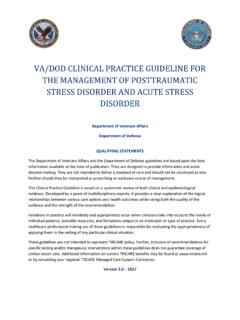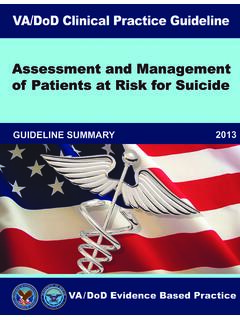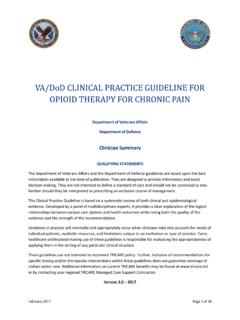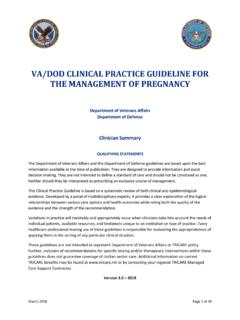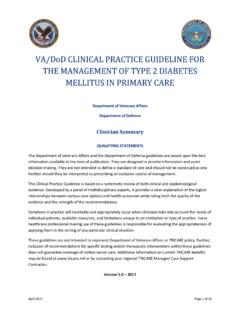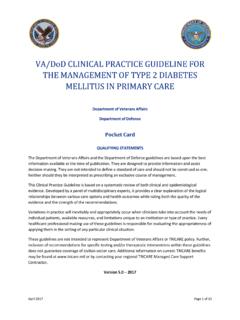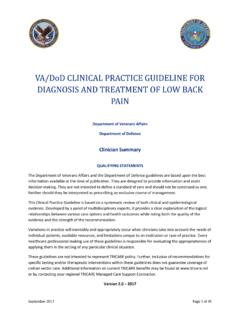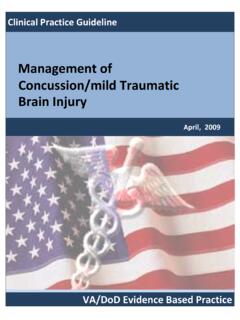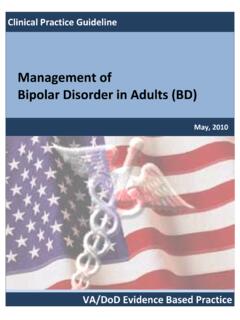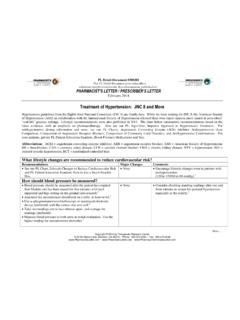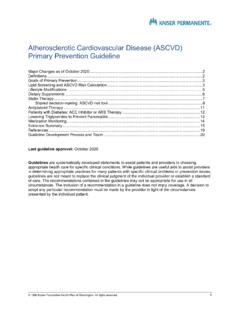Transcription of VA/DoD Clinical Practice Guideline for the Management of ...
1 VA/DoD Clinical Practice Guideline FOR THE Management OF TYPE 2 DIABETES MELLITUS IN PRIMARY CARE Department of Veterans Affairs Department of Defense QUALIFYING STATEMENTS The Department of Veterans Affairs and the Department of Defense guidelines are based upon the best information available at the time of publication. They are designed to provide information and assist decision-making. They are not intended to define a standard of care and should not be construed as one. Neither should they be interpreted as prescribing an exclusive course of Management . This Clinical Practice Guideline is based on a systematic review of both Clinical and epidemiological evidence.
2 Developed by a panel of multidisciplinary experts, it provides a clear explanation of the logical relationships between various care options and health outcomes while rating both the quality of the evidence and the strength of the recommendations. Variations in Practice will inevitably and appropriately occur when clinicians take into account the needs of individual patients, available resources, and limitations unique to an institution or type of Practice . Every healthcare professional making use of these guidelines is responsible for evaluating the appropriateness of applying them in the setting of any particular Clinical situation.
3 These guidelines are not intended to represent Department of Veterans Affairs or TRICARE policy. Further, inclusion of recommendations for specific testing and/or therapeutic interventions within these guidelines does not guarantee coverage of civilian sector care. Additional information on current TRICARE benefits may be found at or by contacting your regional TRICARE Managed Care Support Contractor. Version 2017 April 2017 Page 1 of 160 VA/DoD Clinical Practice Guideline for the Management of Type 2 Diabetes Mellitus in Primary Care April 2017 Page 2 of 160 Prepared by: The Management of Type 2 Diabetes Mellitus in Primary Care Work Group With support from.
4 The Office of Quality, Safety and Value, VA, Washington, DC & Office of Evidence Based Practice , Army Medical Command Version 2017 Based on evidence reviewed through March 2016 VA/DoD Clinical Practice Guideline for the Management of Type 2 Diabetes Mellitus in Primary Care April 2017 Page 3 of 160 Table of Contents .. 5 .. 5 of Diabetes Mellitus .. 5 and Impact .. 7 this Clinical Practice Guideline .. 8 .. 8 of Patient Focus Group Methods and Findings .. 12 of Interest .. 13 of this Clinical Practice Guideline .. 14 Features of this Clinical Practice Guideline .
5 15 Decision-making and Patient-centered Care .. 15 .. 16 Work Group .. 17 .. 18 .. 19 .. 21 Approach to T2DM Care .. 23 Control Targets and 28 harmacological Treatments .. 36 Care .. 41 46 Therapy .. 52 of the Evidence - Monotherapy and Non-Insulin Two-Drug CombinationTherapy .. 54 Therapy .. 56 Therapy .. 57 Outcomes Trials .. 61 Gaps and Recommended Research .. 65 Appendix A: Evidence Review Methodology .. 67 the Scope and Key Questions .. 67 the Systematic Review .. 71 VA/DoD Clinical Practice Guideline for the Management of Type 2 Diabetes Mellitus in Primary Care April 2017 Page 4 of 160 the Face-to-face Meeting.
6 75 Recommendations .. 76 Categorization .. 79 and Submitting the Final Clinical Practice Guideline .. 81 Appendix B: .. 83 inhibitors .. 83 analog .. 84 .. 85 4 inhibitors .. 86 1 peptide receptor agonists .. 87 .. 88 .. 89 glucose co-transporter 2 (SGLT2) inhibitors .. 90 .. 91 .. 92 Appendix C: FDA Approved/ Studied Combination .93 Appendix D: Patient Focus Group Methods and Findings .. 94 .. 94 Focus Group Findings .. 95 Appendix E: Evidence Table .. 97 Appendix F: 2010 Recommendation Categorization Table .. 101 Appendix G: Participant List.
7 131 Appendix H: Literature Review Search Terms and Strategy .. 133 Search Terms .. 133 Appendix I: Acronym List .. 148 References .. 151 VA/DoD Clinical Practice Guideline for the Management of Type 2 Diabetes Mellitus in Primary Care April 2017 Page 5 of 160 Department of Veterans Affairs (VA) and Department of Defense (DoD) Evidence-Based Practice Work Group (EBPWG) was established and first chartered in 2004, with a mission to advise the ..Health Executive Council on the use of Clinical and epidemiological evidence to improve the health of the population across the Veterans Health Administration and Military Health System, by facilitating the development of Clinical Practice guidelines for the VA and DoD populations.
8 [1] This Clinical Practice Guideline (CPG) is intended to provide healthcare providers with a framework by which to evaluate, treat, and manage the individual needs and preferences of patients with diabetes mellitus (DM), thereby leading to improved Clinical outcomes. The first VA/DoD CPG for the Management of Diabetes Mellitus, based upon earlier iterations in 1997 and 2000, was published in 2003.[2] It established a risk stratification approach for setting individualized target goals based upon life expectancy, comorbid conditions, patient preferences, and absolute benefits and potential risks of therapy.
9 [2] It also emphasized the risks of hypoglycemia. In 2010, the VA and DoD published a CPG for the Management of Diabetes Mellitus (2010 DM CPG), which was based on evidence reviewed through June 2009. Since the release of that Guideline , a growing body of research has expanded the general knowledge and understanding of DM. Follow-up of major Clinical trials of intensive therapy, as well as advances in physiological, behavioral, nutritional, and pharmacological research have led to the emergence of new strategies to manage and treat patients with DM. Consequently, a recommendation to update the 2010 DM CPG was made and the update to the 2010 DM CPG was initiated in 2015.
10 The updated CPG includes evidence-based recommendations and additional information on the Management of DM. It is intended to assist healthcare providers in all aspects of patient care, including diagnosis, treatment, and follow-up. The system-wide goal of evidence-based guidelines is to improve the patient s health and well-being by guiding health providers, especially in primary care, to the Management pathways that are supported by evidence. The expected outcome of successful implementation of this Guideline is to: Emphasize shared decision-making to establish patient goals Assess the patient s situation and determine, in collaboration with the patient, the treatmentmethods to achieve the goals.
